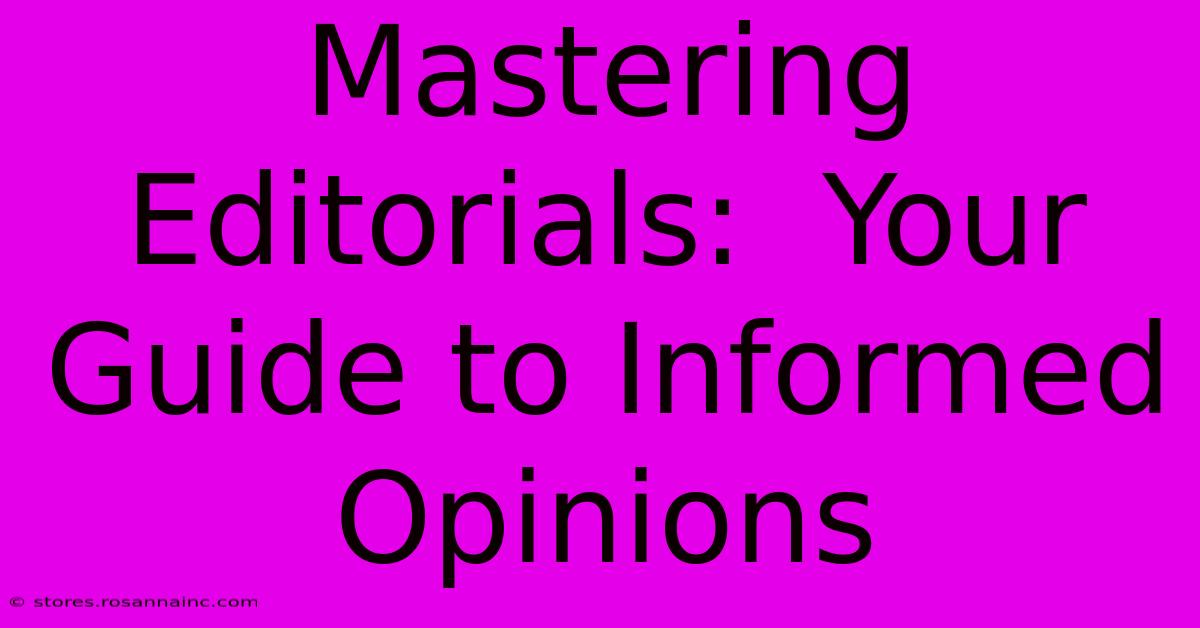Mastering Editorials: Your Guide To Informed Opinions

Table of Contents
Mastering Editorials: Your Guide to Informed Opinions
Writing a compelling editorial isn't just about stating your opinion; it's about persuading your readers to consider—and perhaps even adopt—your viewpoint. This guide will equip you with the tools and techniques to craft impactful editorials that resonate and influence.
Understanding the Editorial Landscape
Before diving into the writing process, it's crucial to understand the purpose and structure of an editorial. Editorials are opinion pieces, typically found in newspapers, magazines, and online publications. They differ from news reports, which present factual information objectively. Editorials, on the other hand, present a specific perspective on a current event, issue, or trend.
Key Characteristics of Effective Editorials:
- Strong Opinion: A clear, concise, and well-defined stance on the topic is paramount. Avoid ambiguity or hedging.
- Persuasive Argumentation: The editorial should present a logical and convincing case, using evidence and reasoning to support the author's claims.
- Engaging Writing Style: Editorials need to be captivating to hold the reader's attention. Use vivid language and compelling storytelling techniques.
- Concise and Focused: Get to the point quickly and avoid unnecessary tangents. Every sentence should contribute to the overall argument.
- Call to Action: Editorials often conclude with a call to action, urging readers to take a specific step, such as contacting their representatives, supporting a cause, or changing their behavior.
Crafting a Powerful Editorial: A Step-by-Step Guide
1. Choosing Your Topic:
Select a timely and relevant issue that genuinely interests you. Passion is contagious, and it will translate into a more engaging and persuasive editorial. Consider topics that are currently being debated or discussed in the media.
2. Conducting Thorough Research:
Thorough research is essential to bolster your argument. Gather facts, statistics, and expert opinions to support your claims. Cite your sources accurately to enhance credibility.
3. Developing a Strong Thesis Statement:
Your thesis statement is the backbone of your editorial. It should clearly state your opinion and outline the main points you will discuss. It's usually found in the introduction.
4. Structuring Your Argument:
Organize your editorial logically, typically using the following structure:
- Introduction: Grab the reader's attention with a hook, introduce the topic, and clearly state your thesis statement.
- Body Paragraphs: Each paragraph should focus on a specific supporting argument, backed by evidence and reasoning. Use transitions to smoothly connect your points.
- Counterarguments: Addressing potential counterarguments demonstrates intellectual honesty and strengthens your overall argument. Acknowledge opposing viewpoints and refute them effectively.
- Conclusion: Summarize your main points, restate your thesis in a new way, and include a compelling call to action.
5. Refining Your Writing:
Once you've written a draft, revise and edit meticulously. Pay attention to clarity, conciseness, and style. Ensure your language is precise and avoids jargon. Read your editorial aloud to catch awkward phrasing or grammatical errors.
Enhancing Your Editorial's Impact:
- Use Anecdotes and Examples: Relatable stories and real-world examples make your argument more engaging and memorable.
- Employ Rhetorical Devices: Figurative language, such as metaphors and similes, can add depth and impact to your writing.
- Appeal to Emotions: While logic is crucial, connecting with your readers' emotions can make your argument more persuasive. However, avoid manipulation.
- Maintain a Professional Tone: Even when expressing strong opinions, maintain a professional and respectful tone. Avoid personal attacks or inflammatory language.
Mastering the art of editorial writing takes practice and dedication. By following these guidelines and continually refining your skills, you can craft informed opinions that resonate with your audience and effectively contribute to public discourse.

Thank you for visiting our website wich cover about Mastering Editorials: Your Guide To Informed Opinions. We hope the information provided has been useful to you. Feel free to contact us if you have any questions or need further assistance. See you next time and dont miss to bookmark.
Featured Posts
-
Podium Pour Nice Face A Lens
Feb 09, 2025
-
Mas Que Antigueedades Las Lecciones Ocultas De El Precio De La Historia
Feb 09, 2025
-
Bundestagswahl 2025 Der Wahl O Mat
Feb 09, 2025
-
Major Quake Hits Caribbean Tsunami Warning Ends
Feb 09, 2025
-
Raymond Robinson Green Man A Tale Of Resilience And Hope
Feb 09, 2025
